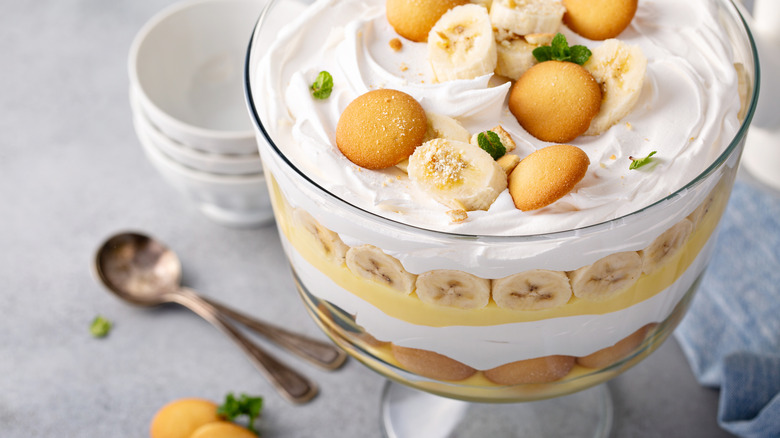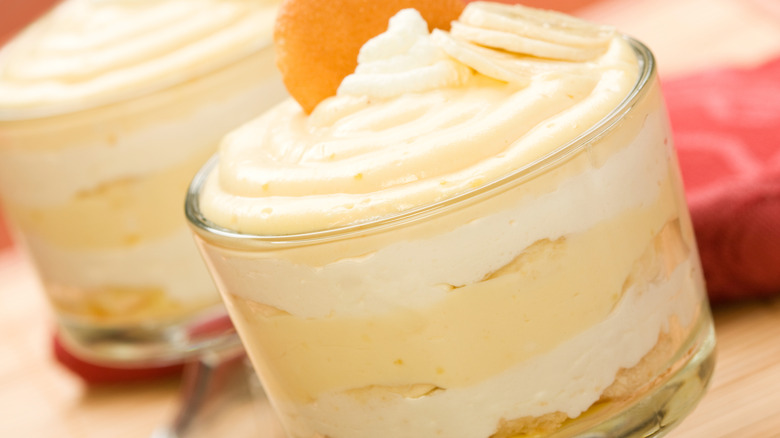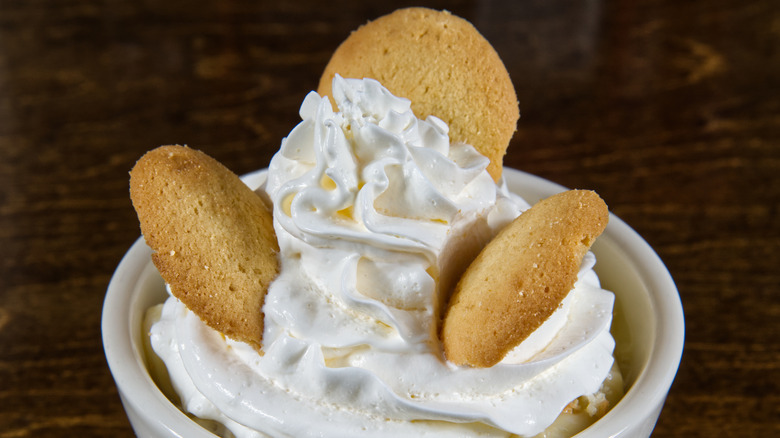How Banana Pudding Became The Queen Of Desserts In The South
U.S. history is layered with global influences, and banana pudding is one of the many American-bred foods that exemplifies that diverse history. Today, many would associate banana pudding with southern comfort food, but some of the dessert's components started elsewhere before arriving in the South.
A typical banana pudding is made up of layers of vanilla pudding, vanilla wafers, and of course, slices of banana stacked on top of each other. Often a whipped cream or meringue topping is added as well. How this light but creamy dessert came to the South is a bit of a complex story, considering bananas originated in the Caribbean and Latin America. Plus, the dessert bears an undeniable resemblance to an English trifle, which also layers fruit and custard among other ingredients.
The popularization of the "exotic" banana in the 1800s, innovations in consumer packaged goods, and good old southern hospitality — each of these factors contributed to banana pudding taking its spot as the queen of southern desserts. Although banana pudding is not my dessert of choice, I do find its history fascinating enough to take a quick bite into.
Where did banana pudding come from?
Just like the dessert itself, banana pudding's origin story has many layers. In the post-Civil War era, trade began to boom and faster steamships made it possible for more perishable items like bananas to make their way to American ports. From 1895 to 1900 imports of banana bunches increased from 12.5 million to 16 million.
Though still considered "exotic," bananas grew in popularity around this time, and chefs began incorporating them more into everyday cooking. The earliest surviving reference to banana pudding dates back to 1878 in a column in the New York Times where a reader requested the recipe.
Many early recipes layered sponge cake with the bananas and custard, much like a classic English trifle. A recipe that appeared in Good Housekeeping in 1888 instructed readers to make and chill a pint of custard and line a dish with alternating layers of sponge cake and sliced bananas. However, it wasn't until the introduction of vanilla wafers into the dessert that banana pudding truly became what we know today.
Nilla wafers, made by Nabisco, are the wafer brand commonly used for banana pudding. The company has taken credit for adding wafers to the banana pudding formula, but evidence suggests that home cooks were the first to add Nilla wafers to banana pudding after the cookies were introduced in 1900. There's no record of Nabisco printing banana pudding recipes on Nilla wafer boxes until the '40s.
Why did banana pudding become so popular in the South?
Regardless of Nilla wafers' timeline, innovations in industrial food manufacturing played a large role in making banana pudding a southern icon. Just as Nabisco capitalized on the use of its product in banana pudding recipes, other brands also found ways to use banana pudding to their advantage.
Instead of making meringue or whipped cream from scratch, by 1966 home cooks could spread on a premade whipped topping like Cool Whip from General Mills. To make the recipe even more convenient, some people started using instant pudding mix instead of custard. Jell-O even came out with a banana cream-flavored pudding in 1964 and promoted the product by telling customers they could now have banana flavor all throughout their southern banana pudding.
While banana pudding had clearly taken on a southern identity by the 1960s, the reasons as to why are not completely clear. Some posit that it's because the dessert is easy to make in bulk and doesn't require you to fire up a hot oven in the southern summer heat. The dessert is great for entertaining because it can be easily transported and served and doesn't have to be kept warm.
Others note that the importation of bananas through southern trade ports contributed to the eventual identification of banana pudding as southern. However this layered dessert came to be, its reign as a southern queen has certainly remained strong.


